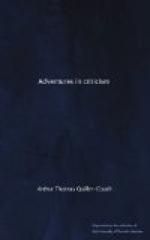The “Ballad of a Nun.”
Since its appearance, a few weeks back, all the critics have spoken of “A Ballad of a Nun,” and admitted its surprising strength and beauty. They have left me in the plight of that belated fiddle in “Rejected Addresses,” or of the gentleman who had to be content with saying “ditto” to Mr. Burke. For once they seem unanimous, and for once they are right. The poem is beautiful indeed in detail:
“The adventurous
sun took Heaven by storm;
Clouds scattered
largesses of rain;
The sounding cities,
rich and warm,
Smouldered
and glittered in the plain.”
Dickens, reading for the first time Tennyson’s “Dream of Fair Women,” laid down the book, saying, “What a treat it is to come across a fellow who can write!” The verse that moved him to exclaim it was this—
“Squadrons and
squares of men in brazen plates,
Scaffolds,
still sheets of water, divers woes,
Ranges of glimmering
vaults with iron grates;
And hushed
seraglios.”
It is not necessary to compare these two stanzas. Tennyson’s depicts a confused and moving dream; Mr. Davidson’s a wide earthly prospect. The point to notice in each is the superlative skill with which the poet chooses the essential points of the picture and presents them so as to convey their full meaning, appealing at once to the senses and the intelligence. Tennyson, who is handling a mental condition in which the sensations are less sharply and logically separated than in a waking vision, can enforce this second appeal—this appeal to the intelligence—by introducing the indefinite “divers woes” between the definite “sheets of water” and the definite “ranges of glimmering vaults with iron grates”: just as Wordsworth, to convey the vague unanalyzed charm of singing, combines the indefinite “old unhappy far-off things” with the definite “battles long ago.” Mr. Davidson, on the other hand, is describing what the eye sees, and conveying what the mind suspects, in their waking hours, and is therefore restricted in his use of the abstract and indefinite. Notice, therefore, how he qualifies that which can be seen—the sun, the clouds, the plain, the cities that “smoulder” and “glitter”—with the epithets “sounding,” “rich,” and “warm,” each an inference rather than a direct sensation: for nobody imagines that the sound of the cities actually rang in the ear of the Nun who watched them from the mountain-side. The whole picture has the effect of one of those wide conventional landscapes which old painters delighted to spread beyond the court-yard of Nazareth, or behind the pillars of the temple at Jerusalem. My attempt to analyze it is something of a folly; to understand it is impossible:




